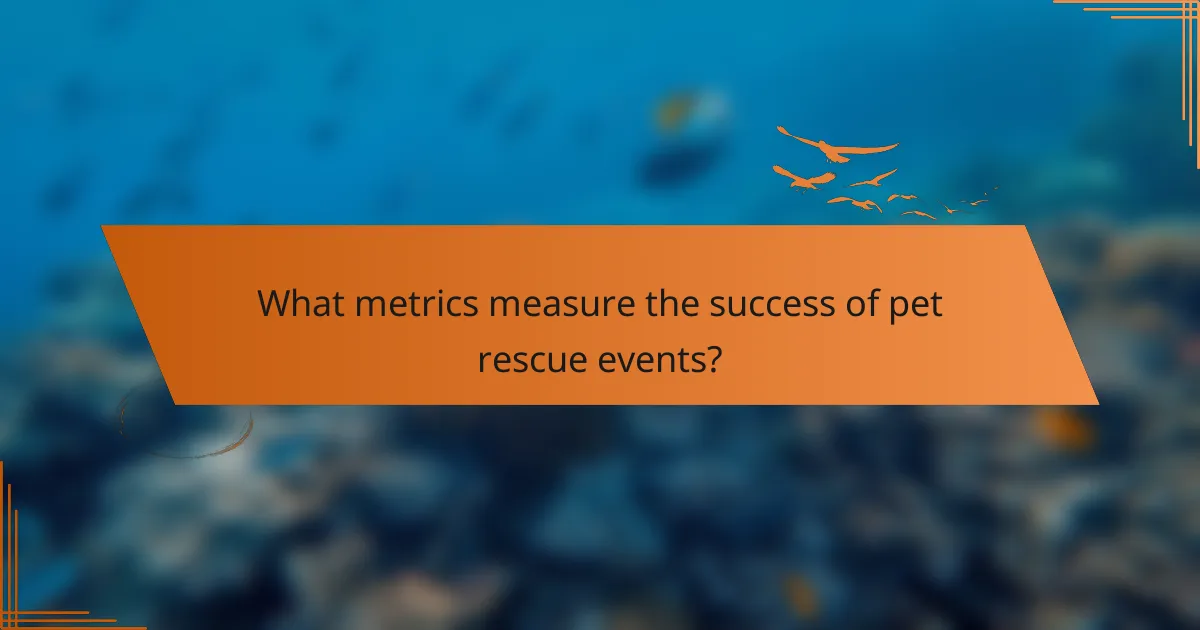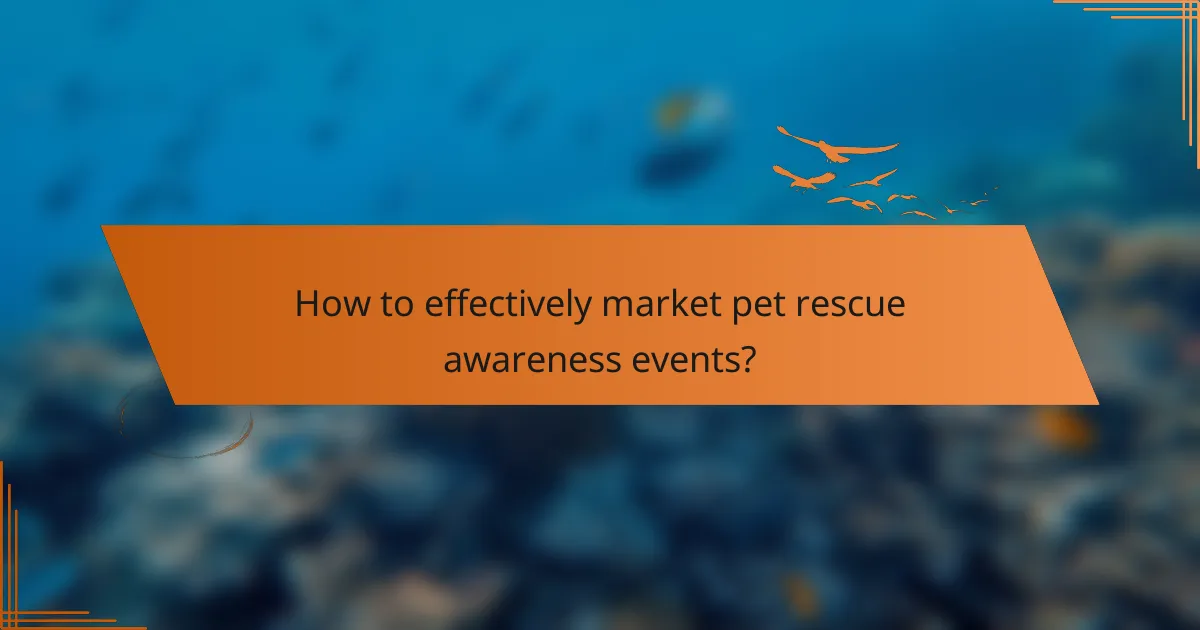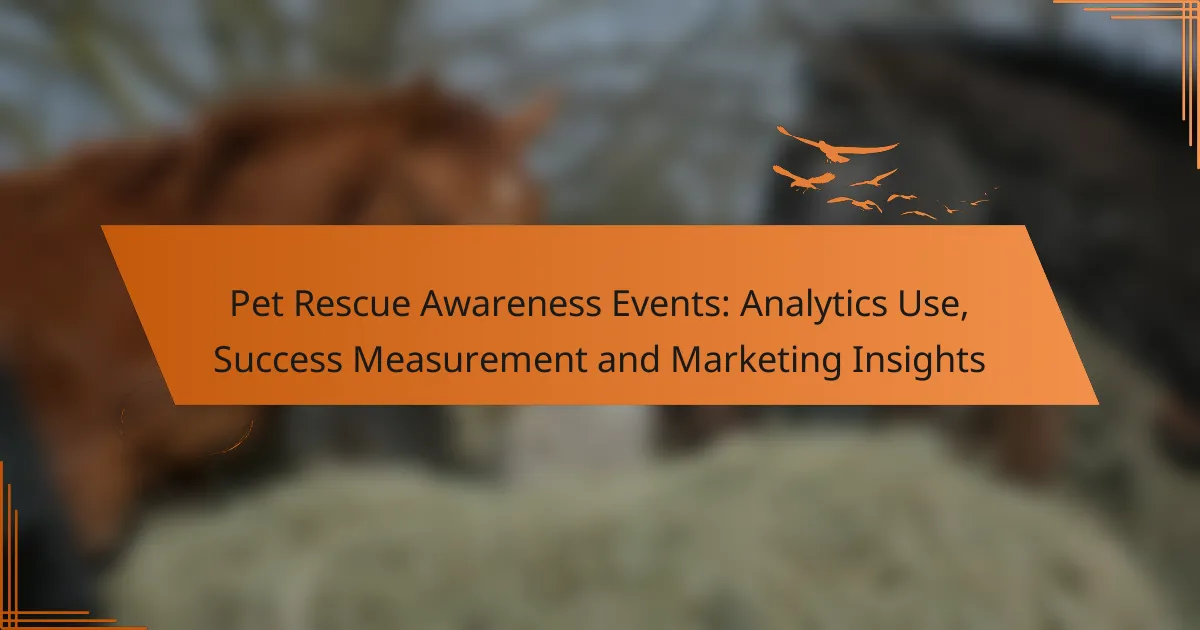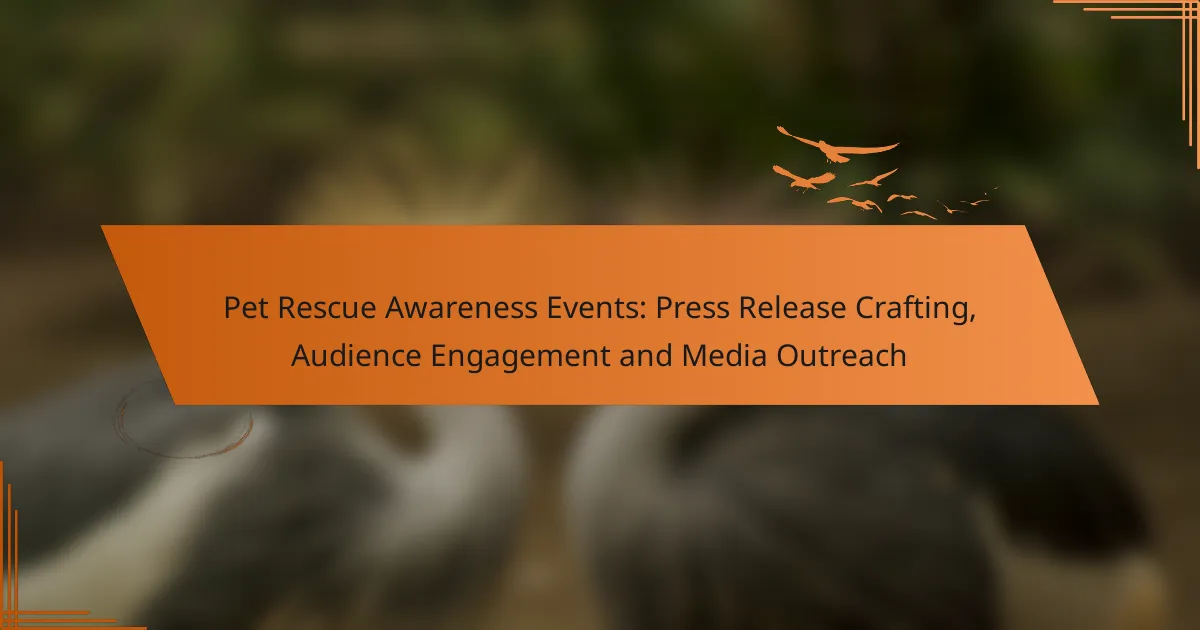Pet rescue awareness events play a crucial role in promoting animal welfare, and leveraging analytics can greatly enhance their impact. By understanding attendee behavior and preferences, organizations can refine their strategies to boost engagement and measure success through key metrics such as attendance and adoptions. Effective marketing that resonates emotionally with the audience and utilizes diverse outreach channels is essential for maximizing participation and community involvement.

How can analytics improve pet rescue awareness events?
Analytics can significantly enhance pet rescue awareness events by providing insights into attendee behavior, preferences, and overall event effectiveness. By leveraging data, organizations can tailor their strategies to increase engagement and drive better outcomes.
Data-driven decision making
Data-driven decision making involves using analytics to guide choices about event planning and execution. By analyzing past event data, organizers can identify what worked well and what didn’t, allowing for informed adjustments in future events. For instance, if attendance was low at a specific venue, it may be wise to consider alternative locations.
Utilizing tools like surveys and feedback forms can help gather valuable data from participants. This information can be used to refine marketing strategies, improve logistics, and enhance the overall experience for attendees.
Target audience identification
Identifying the target audience is crucial for the success of pet rescue awareness events. Analytics can help organizations segment their audience based on demographics, interests, and past engagement levels. This allows for more personalized marketing efforts that resonate with potential attendees.
For example, if data shows that a significant portion of past attendees were young families, promotional materials can be tailored to highlight family-friendly activities at the event. This targeted approach can lead to higher attendance rates and increased community involvement.
Event performance tracking
Tracking event performance is essential to measure success and identify areas for improvement. Key performance indicators (KPIs) such as attendance numbers, donations collected, and social media engagement can provide a clear picture of how well the event met its goals.
Setting up a system to monitor these metrics in real-time can help organizers make necessary adjustments during the event. For instance, if donation levels are lower than expected, additional fundraising activities can be introduced to boost contributions.
Social media engagement analysis
Analyzing social media engagement is vital for understanding how well the event is resonating with the community. Metrics such as likes, shares, comments, and overall reach can provide insights into the effectiveness of promotional campaigns. By tracking these metrics, organizations can gauge public interest and adjust their messaging accordingly.
For instance, if a particular post about a featured pet receives high engagement, similar content can be prioritized in future campaigns. Additionally, using social media analytics tools can help identify the best times to post and the types of content that generate the most interaction, optimizing outreach efforts for future events.

What metrics measure the success of pet rescue events?
Success for pet rescue events can be measured through various metrics that reflect attendance, fundraising, adoptions, and community involvement. These indicators provide insight into the effectiveness of the event and areas for improvement.
Attendance numbers
Attendance numbers are a primary metric for gauging the success of pet rescue events. A higher turnout typically indicates greater interest and awareness in the community. Tracking attendance can help organizers understand which marketing strategies are most effective.
To assess attendance, consider not only the total number of participants but also the demographics of attendees. Knowing who attends can guide future outreach efforts and event planning.
Fundraising totals
Fundraising totals are crucial for measuring the financial success of pet rescue events. These figures reflect the amount of money raised through ticket sales, donations, and sponsorships. A successful event should aim to exceed previous fundraising benchmarks.
When analyzing fundraising totals, consider the costs associated with the event to determine net profit. Setting clear financial goals before the event can help in evaluating its success post-event.
Adoption rates
Adoption rates indicate how many pets found new homes during or after the event. This metric is vital for assessing the event’s impact on reducing the number of homeless animals. High adoption rates suggest effective matchmaking and community engagement.
To improve adoption rates, ensure that pets are well-prepared for adoption, including vaccinations and spaying/neutering. Collaborating with local veterinarians can enhance the adoption process and increase the likelihood of successful matches.
Community engagement levels
Community engagement levels reflect how well the event connects with the local population. This can be measured through social media interactions, volunteer participation, and partnerships with local businesses. Engaged communities are more likely to support future events and initiatives.
To boost community engagement, consider hosting interactive activities, such as pet training demonstrations or educational workshops. Gathering feedback from attendees can also provide valuable insights for future events and strengthen community ties.

How to effectively market pet rescue awareness events?
To effectively market pet rescue awareness events, focus on engaging your audience through multiple channels, creating a strong emotional connection, and providing clear calls to action. Utilize a mix of digital and local outreach strategies to maximize visibility and participation.
Social media campaigns
Social media campaigns are essential for reaching a broad audience quickly. Platforms like Facebook, Instagram, and Twitter allow you to share compelling stories, images, and videos of pets in need, which can evoke emotional responses and encourage sharing.
Consider using targeted ads to reach specific demographics interested in animal welfare. Engaging content, such as countdowns to the event or behind-the-scenes preparations, can build excitement and anticipation.
Email marketing strategies
Email marketing remains a powerful tool for promoting pet rescue awareness events. Create a segmented email list to tailor messages to different audiences, such as past donors, volunteers, or local pet owners.
Include clear information about the event, such as date, time, location, and how attendees can help. Use engaging subject lines and visuals to increase open rates, and consider offering incentives, like early bird registration discounts or exclusive merchandise.
Partnerships with local businesses
Forming partnerships with local businesses can enhance your marketing efforts and expand your reach. Collaborate with pet stores, veterinary clinics, or cafes to display promotional materials or host joint events.
These partnerships can also include sponsorship opportunities, where businesses provide financial support in exchange for advertising space at your event. This not only increases funding but also builds community ties.
Influencer collaborations
Collaborating with local influencers can significantly amplify your event’s visibility. Identify pet-related influencers or community figures who share a passion for animal welfare and have a substantial following.
Engage them to promote your event through their channels, whether by sharing posts, hosting giveaways, or attending the event. Their endorsement can lend credibility and attract a wider audience, especially among younger demographics.

What are the best practices for organizing pet rescue events?
Organizing successful pet rescue events requires careful planning and execution. Key practices include setting clear goals, selecting appropriate venues, engaging volunteers effectively, and creating compelling content to attract attendees.
Setting clear goals
Establishing clear goals is essential for any pet rescue event. These goals should be specific, measurable, achievable, relevant, and time-bound (SMART). For instance, aim to raise a certain amount of funds, increase adoption rates, or boost community awareness.
Consider setting both short-term and long-term objectives. Short-term goals might focus on the immediate success of the event, while long-term goals could involve building ongoing relationships with the community and potential adopters.
Choosing the right venue
Selecting the right venue can significantly impact the success of your pet rescue event. Look for locations that are accessible, spacious, and pet-friendly, such as parks, community centers, or local pet shops. Ensure the venue can accommodate the expected number of attendees and their pets.
Consider the amenities available at the venue, such as restrooms, parking, and shelter from inclement weather. A well-chosen venue can enhance the overall experience for both pets and attendees, encouraging participation and engagement.
Engaging volunteers
Volunteers are the backbone of any successful pet rescue event. Recruit individuals who are passionate about animal welfare and can contribute various skills, such as event planning, marketing, or animal handling. Clearly define roles and responsibilities to ensure smooth operations.
Provide training and orientation for volunteers to equip them with the necessary knowledge about the event and the animals involved. Recognize and appreciate their efforts through small tokens of gratitude or volunteer appreciation events to foster a positive atmosphere.
Creating compelling content
Compelling content is crucial for attracting attendees to your pet rescue event. Use engaging visuals, such as photos and videos of the animals available for adoption, to capture attention on social media and promotional materials. Share heartwarming stories that highlight the impact of the rescue organization.
Consider creating a content calendar leading up to the event, featuring countdowns, sneak peeks, and behind-the-scenes looks. This strategy can build excitement and encourage community involvement, ultimately leading to higher attendance and support for your cause.

What tools can help with event analytics?
Event analytics tools provide insights into attendee behavior, engagement, and overall event success. Utilizing these tools can help pet rescue organizations measure the effectiveness of their events and improve future initiatives.
Google Analytics
Google Analytics is a powerful tool that tracks website traffic and user interactions. For pet rescue events, it can monitor how many visitors are coming to the event page, where they are coming from, and what actions they take, such as signing up or donating.
To effectively use Google Analytics, set up specific goals related to your event, such as ticket sales or newsletter sign-ups. Utilize UTM parameters in your marketing links to track the performance of different campaigns. Regularly review the data to identify trends and areas for improvement.
Eventbrite analytics
Eventbrite offers built-in analytics specifically designed for event management. This tool provides insights into ticket sales, attendee demographics, and engagement levels, making it easier for pet rescue organizations to assess their event’s reach and impact.
When using Eventbrite, pay attention to the dashboard metrics, which can show you real-time ticket sales and attendee check-ins. Use this information to adjust your marketing strategies on the fly. Additionally, consider sending post-event surveys through Eventbrite to gather feedback and improve future events.



